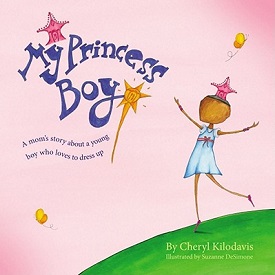My Princess Boy facts for kids
 |
|
| Author | Cheryl Kilodavis |
|---|---|
| Illustrator | Suzanne DeSimone |
| Cover artist | Suzanne DeSimone |
| Country | United States |
| Language | English |
| Genre | Picture book |
| Publisher | KD Talent, LLC |
|
Publication date
|
2009 |
| Media type | |
| Pages | 36 |
| ISBN | 9781442429888 |
| OCLC | 681503510 |
My Princess Boy is a children's picture book from 2009. It was written by Cheryl Kilodavis and illustrated by Suzanne DeSimone. The story is about a boy who loves "pretty things." He likes to wear tiaras and "girly dresses."
The book teaches readers about supporting children. It shows that it's important to accept kids for who they are. Even when people notice his unique style, the Princess Boy always has his family's love. His family supports him throughout the whole story.
Some people have different opinions about the book. However, many experts say it's helpful. They believe it introduces the idea of being yourself. It helps families, classrooms, and libraries talk about different ways people express themselves.
What the Story is About
My Princess Boy starts with the narrator. She is the Princess Boy's mother. She introduces the Princess Boy and what he likes to do. The narrator describes his family and friends.
Then, the story shows a challenge. Some people react to the Princess Boy's style. The narrator shares how people sometimes laugh or stare at him. This happens when he wears or buys "girly" things. But through it all, the Princess Boy's family is always there. They give him constant comfort, support, and love.
How the Book Was Created
The story was inspired by Cheryl Kilodavis's own son, Dyson. Kilodavis wanted to help people accept differences. She wanted to show that it's okay for kids to express themselves in their own way.
When Dyson was about two years old, he started creating his own style. He liked jewelry and dresses. Around that time, Dyson told his mom, "I am a Princess Boy, Mommy!"
Kilodavis first found it hard to fully accept her son's choices. She tried to get him to like "boy" things. She also tried to steer him away from "girly" things. But her older son, Dkobe, helped her see things differently. When Dkobe was six, he asked his mom, "Why can't you just let him be happy, Mom?" This question changed how Kilodavis and her family thought.
Kilodavis also found it hard to find positive books for Dyson. This made her want to write My Princess Boy. She wanted to create a story that would help her son.
Kilodavis also learned a lot from her own childhood. She learned to understand herself and what felt right. She felt different growing up too. She wanted to write a book that would help people talk about accepting differences.
She also mentioned a book called Free to Be… You and Me. This book helped her as a writer and a mother. It taught about respect and acceptance. Kilodavis felt that Free to Be… You and Me helped prepare people to accept her own book.
Publishing the Book
After talking with Dyson's daycare, Kilodavis decided to write the book. It was a way to show her support for her son. She worked with an illustrator. Then, she made a few copies of the book. She gave one to Dyson's teacher.
Next, Kilodavis created a website to sell copies. Soon, many people wanted the book. She received many orders and a lot of support. It became hard for her to make enough copies of the book.
Kilodavis first hired a local printer. They made 100 books to sell on Amazon. But then, the book was shown on a TV show. After that, many more people wanted it. Kilodavis said, "Within 24 hours there was a waiting list for the book." She also got over 500 emails from people around the world. It was a huge response.
Because of all the media attention, Kilodavis connected with Simon & Schuster. This is a big publishing company.
Kilodavis was worried that a publisher might change her story. She said, "I was so afraid they would change the story." But Simon & Schuster wanted to publish the book exactly as it was. They quickly made a deal. The book was published within two months.

